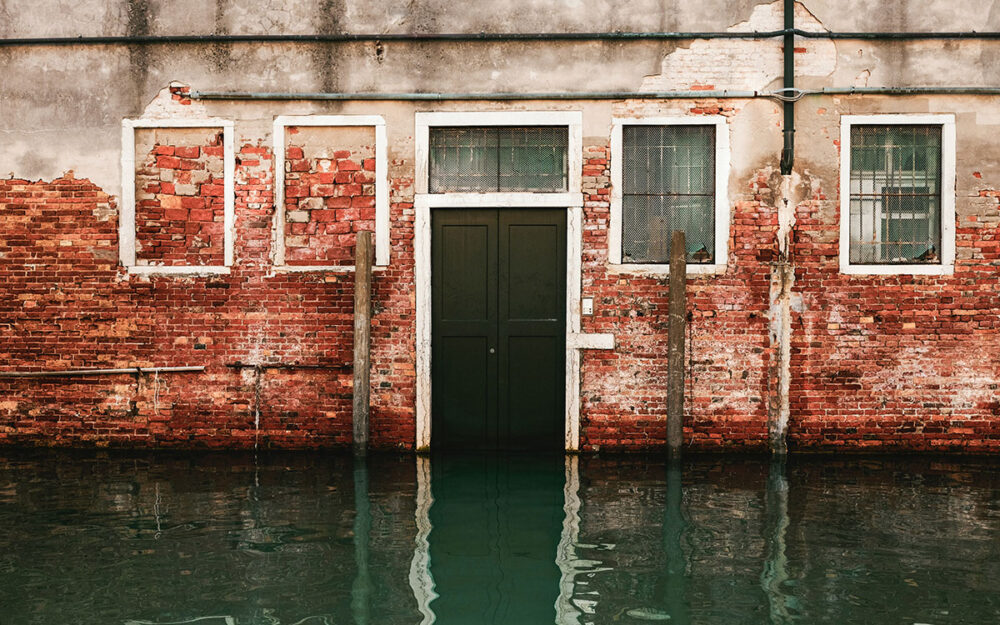
When the water came, Alex Gibson was prepared for, as he put it, “regular flooding.” But regular flooding was not what surged through multiple counties in Eastern Kentucky in late July of 2022, killing over 40 people and displacing thousands from their homes.
For five days, heavy rain struck an area already vulnerable from decades of exploitation. “It wasn’t just that the water was at historic levels,” Gibson says. “It’s that we also had corporate malpractice. It’s that we had ages of mining practices that were underregulated to not regulated at all.”
Strip mining, clearcutting trees, and mountaintop removal had left the land exposed to runoff—and left few roots, topsoil, or vegetation to hold the ground in place. As Grist reported, in less than 24 hours, some areas in Eastern Kentucky saw river levels rise by 25 feet.
A Gathering Point for Artists
One of those rivers was the North Fork of the Kentucky River, which overran its banks, coursing through the town of Whitesburg in southeastern Kentucky. Among the many buildings impacted was the long-time headquarters of Appalshop. Founded in 1969, the nonprofit then known as the Appalachian Film Workshop was one of the community film workshops created in partnership with the American Film Institute and the federal Office of Economic Opportunity.
Appalshop has since expanded to be a media, arts, and education center. As Gibson, Appalshop’s executive director since 2014, says, “Filmmaking equipment was really at the peak of modern technology” in 1969. Some of the center’s many offerings included providing film equipment and training to the community. “There was a new, alternative way to make a living that folks didn’t dream would be possible in the mountains” says Gibson. “Appalshop started to become a gathering point for artists, cultural workers from the region to come and express themselves.”
In the 1980s, an artist from outside the region stopped by the nonprofit and mentioned he could build radio stations. Filmmakers and community members became radio DJs, and Mountain Community Radio (WMMT 88.7 FM) was born. It is now a popular station with music, news, and cultural programing, which serves much of the central portion of Appalachia, reaching parts of Virginia and West Virginia as well as Kentucky.
“And that kept on happening with Appalshop, with people coming and bringing their artistic talents, until we ended up with the filmmaking workshop, the radio station, the theater company,” Gibson remembers.
Archives in Danger
Appalshop’s 150-seat theater had recently been renovated when the 2022 floods struck. The theater was located on the first floor of the large, historic building, as was the radio station. “During a flood like this, if you could have kept one thing going, you would have hoped it would have been the radio station,” Gibson says. The floodwaters reached into the first floor of the building, and in Appalshop’s adjacent space, they reached the archives.
The archives contain thousands of items pertaining to the culture, history, and people of the Appalachian region, from quilts to handmade musical instruments to newspapers and magazines to family photographs and memorabilia. Considering the building’s close proximity to the river, everything in the archive was stored above ground level. “We had started at shelf three and then up. So we were prepared. It had never gotten anywhere near shelf one,” says Gibson.
When the floods began in late July, staff members of Appalshop initially felt concerned with potential rain damage to their roof, but the river rose quickly. Within an hour, Gibson and others learned the flooded river had made any path going to Appalshop impassable. Photos would circulate of this time: devastating images of the distinctive brown building completely surrounded by murky water. Appalshop had become an island.
Eventually the river would reach over 28 feet. “That level of water in our area is the largest reported ever,” Gibson says.
Telling a Larger Story
In the wake of the floods, archivists from across the country rushed to central Appalachia to volunteer and try and preserve what they could, rescuing documents and artifacts coated in mud and chemicals from the overflowing silt ponds. Appalshop is also now working with a restoration film company. “Fundamentally, it’s a question of money,” says Gibson. “The technology has reached the point where these materials largely could be saved. It’s just a resource question.”
At the height of the emergency, with power out in many places, Appalshop knew the radio station had to be restored, communicating essential information to the community as soon as possible. Their solution? An RV.
Sign up for our free newsletters
Subscribe to NPQ's newsletters to have our top stories delivered directly to your inbox.
By signing up, you agree to our privacy policy and terms of use, and to receive messages from NPQ and our partners.
“There are still very many people for whom this flood devastated and destroyed their lives. And some of those people can’t see a way out.”
After weeks of being off the air, Appalshop was able to move the radio station into a recreational vehicle nicknamed “The Possum Den.” Gibson explains, “It’s a mobile station, so that if any other weather event does happen, we can move and alert other people as to the danger and stay on the air during crisis time.”
Staff at Appalshop realized that the people of Eastern Kentucky need up-to-date information and assistance, especially in the face of increasing climate emergencies, and the mobile radio station was one way to do that.
One year after the floods, much of the country has moved on, but for many of those impacted by the disaster, such closure is impossible. “There are still very many people for whom this flood devastated and destroyed their life. And some of those people can’t see a way out,” says Gibson.
According to NPR, more than 10,000 homes were damaged or completely destroyed, and as the Kentucky Center for Economic Policy wrote a month after the floods, “the median award for 4,092 claims so far from the eastern Kentucky flood is only $2,200.”
“We’re interested in looking at how climate events affect people like us. … And I think we’re telling this story in every artistic medium that we have.”
Appalshop staff members took it upon themselves to independently help their community, raising tens of thousands of dollars in mutual aid. Community support is a key aspect of Appalshop, as is respecting the work of artists and storytellers. “We’re trying to keep artists paid,” Gibson says. “Everybody at Appalshop has health insurance. Everybody has a retirement fund. We have a wellness program. These are not things that are common for filmmakers or painters.”
Telling and preserving stories of the Appalachian region has always been at the heart of Appalshop’s work. Though the shape of those stories continues to grow and change, one story is about climate change in central Appalachia and making the case as to why these narratives are becoming increasingly urgent.
According to Gibson, even though they have as of yet been unable to move back into their offices, the nonprofit is already documenting the flood in various ways. “We’re interested in looking at how climate events affect people like us. . . . And I think we’re telling that story in every artistic medium that we have.”
“It’s very important that folks don’t just understand it as rain. It wasn’t the rain’s fault.”
The floods that struck Eastern Kentucky are part of a larger story of misuse of the environment and the exploitation of vulnerable people. Gibson talks of the area’s history of clearcutting, felled trees left on the ground that became “missile projectiles” in the rapidly moving flood. He speaks of the toxins that were in the rising waters, heavy metals left over from the mining process that had washed into flooded streams. “So it’s not just the water and the environment and an act of God. It’s decisions by generations of government and corporate malfeasance. . . . It’s very important that folks don’t just understand it as rain. It wasn’t the rain’s fault.”
“[Continuing to support] issues of climate change . . . supports the most vulnerable people in the world,” Gibson says. “Not just Appalachians, but every group of people who don’t have the money to just leave and move to higher ground.”













